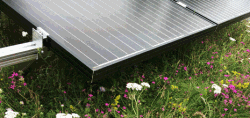Building for the future
Meeting Planning, the Merton Rule and Delivering Low or Zero Carbon (LZC) Technologies
The Merton Rule was a pioneering planning policy, developed by Merton Council in 2003, which at the time asked new commercial developments over 1000m2 to generate at least 10% of their energy needs from site sourced renewable energy, in order to help reduce annual carbon dioxide (CO2) emissions in the built environment.
In 2008, the Government published its central planning guidance 'Planning Policy Statement: Planning and Climate Change – PPS1' that requires all UK local planning authorities to adopt a ‘Merton Rule’ policy and more specifically within 'PPS22 Renewable Energy', which planning authorities should acknowledge when preparing local development documents and making planning decisions. To date, the vast majority of councils have embraced the rule adopting pro-renewables planning policies within Unitary Development Plans or Supplementary Planning Documents.
In Scotland, the Government has set clear targets for renewable electricity with the First Minister wanting renewable sources to generate the equivalent of 100% of Scotland’s gross annual electricity consumption by 2020. In addition to these planning resolutions, BREEAM requirements for buildings often call for site sourced renewables with a minimum of 30% CO2 reduction from site based renewables required to achieve maximum credits.
With this background, all building designers, constructors and developers need to consider the options for on-site renewable energy and satisfying these obligations is frequently a driver for including a photovoltaic array on a roof. A flat roof being the ideal location for unobtrusive energy generation. Our Solar PV solutions deliver these obligations on flat roofs without any penetrations of the waterproofing system to safeguard the integrity of the building.
Uniting the challenges
The real challenge arises when a planning pre-requisite is placed on urban development to combine a green roof and a renewable energy system and how to locate both within the same, and often size limited, roof area. A feasible solution is to layer the
green roof and
PV array with our
BioSOLAR solution which means the systems can co-habit the same area and mutually benefit each other.
The distinctiveness of the system is in the design of the mounting system whereby the substrate and vegetation provide the ballasted installation mechanism to secure the array to the roof. The
BioSOLAR system also increases the efficiency of the solar array because the vegetation preserves ambient rooftop temperatures, keeping the PV modules at optimal output and increasing energy yields by 5% - 7%.
Sustainable solutions for successful planning
One of the key advantages of our
BioSOLAR system is that the entire roof area qualifies as a green roof, and if a biodiversity vegetation finish is chosen it can further enhance the
BREEAM credit rating for the roof element.

Downloads
ISO 9001 Certificate ►
ISO 14001 Certificate ►
ISO 50001 Certificate ►
EPDs ►